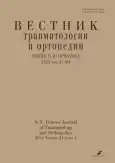Application of additive technologies in the treatment of patients with gunshot wounds of the elbow joint
- Authors: Kerimov A.A.1, Kukushko E.A.1, Murzin E.A.1, Onnitsev I.E.1, Khominets I.V.1, Besedin V.D.1, Kucherenko A.A.1
-
Affiliations:
- Main Military Clinical Hospital named after academician N.N. Burdenko
- Issue: Vol 31, No 4 (2024)
- Pages: 527-541
- Section: Original study articles
- URL: https://bakhtiniada.ru/0869-8678/article/view/310535
- DOI: https://doi.org/10.17816/vto633887
- ID: 310535
Cite item
Abstract
BACKGROUND: Management of patients with upper extremity gunshot wounds that have destroyed the elbow joint is a major challenge in modern traumatic and orthopedic surgery.
AIM: To assess medium-term surgical outcomes in patients with upper extremity gunshot wounds that have destroyed the elbow joint who received combination treatment using additive technology.
MATERIALS AND METHODS: Between 2022 and 2024, 25 patients with upper extremity gunshot wounds that have destroyed the elbow were treated using additive technology in the Center for Traumatology and Orthopedics of the Burdenko Main Military Clinical Hospital of the Ministry of Defense of Russia. All patients were male, with a mean age of 34.5±7.82 years. The mean time from injury to elbow replacement surgery was 193±39 days. The range of motion in the elbow joint was assessed. The QuickDASH and the Oxford Elbow Score were used to subjectively assess treatment outcomes after 3 and 6 months. CT examinations were performed at each stage.
RESULTS: A follow-up examination after 6 months showed an improvement in the range of motion in the majority of patients. The following criteria indicated a positive outcome: range of motion without limitations (Table 4, RF Government Decree No. 565 of July 4, 2013, On Approval of the Regulation on Military Medical Examination), QuickDASH score <45, and Oxford Elbow Score >70. The outcome was good in 17 (68%) patients and satisfactory in 5 (20%) patients. Three (12%) patients had postoperative complications (one patient’s elbow implant component was destroyed, and two patients developed deep periprosthetic infections), resulting in poor outcomes. Thus, the elbow joint function was successfully restored using additive technology in 22 (88%) patients.
CONCLUSION: In patients with upper extremity gunshot wounds that have destroyed the elbow joint, additive technology rapidly and completely restores the upper extremity function. However, the long-term outcomes of this treatment need to be investigated further.
Full Text
##article.viewOnOriginalSite##About the authors
Artur A. Kerimov
Main Military Clinical Hospital named after academician N.N. Burdenko
Email: kerartur@yandex.ru
ORCID iD: 0000-0001-5783-6958
SPIN-code: 3131-1308
MD, Cand. Sci. (Medicine)
Russian Federation, 3 Gospitalnaya pl., 105094 MoscowEvgeniy A. Kukushko
Main Military Clinical Hospital named after academician N.N. Burdenko
Email: doctrauma87@gmail.com
ORCID iD: 0000-0002-2941-9601
SPIN-code: 6736-1323
MD
Russian Federation, 3 Gospitalnaya pl., 105094 MoscowEvgeniy A. Murzin
Main Military Clinical Hospital named after academician N.N. Burdenko
Author for correspondence.
Email: murzin1992@list.ru
ORCID iD: 0000-0003-2879-6509
SPIN-code: 9952-2795
MD
Russian Federation, 3 Gospitalnaya pl., 105094 MoscowIgor E. Onnitsev
Main Military Clinical Hospital named after academician N.N. Burdenko
Email: ionnicev@mail.ru
ORCID iD: 0000-0002-3858-2371
SPIN-code: 9659-4740
MD, Dr. Sci. (Medicine)
Russian Federation, 3 Gospitalnaya pl., 105094 MoscowIgor V. Khominets
Main Military Clinical Hospital named after academician N.N. Burdenko
Email: khominets24_91@mail.ru
ORCID iD: 0000-0003-0964-653X
SPIN-code: 5928-5370
MD, Cand. Sci. (Medicine)
Russian Federation, 3 Gospitalnaya pl., 105094 MoscowVladimir D. Besedin
Main Military Clinical Hospital named after academician N.N. Burdenko
Email: BesedinVD@yandex.ru
ORCID iD: 0000-0001-9087-1421
SPIN-code: 9908-6830
MD
Russian Federation, 3 Gospitalnaya pl., 105094 MoscowAnna A. Kucherenko
Main Military Clinical Hospital named after academician N.N. Burdenko
Email: gaydykovaanna94@gmail.com
ORCID iD: 0009-0000-1884-8446
SPIN-code: 9391-4436
Russian Federation, 3 Gospitalnaya pl., 105094 Moscow
References
- Khominets VV, Kudyashev AL, Dresvyannikov AS, et al. Experimental assessment of the severity of concussion injury of the knee and elbow joints. Vestnik Rossijskoj voenno-medicinskoj akademii. 2016;(2):126–130. (In Russ.). EDN: WDCIKT
- Trishkin DV, Kryukov EV, Alekseev DE, et al. Military field surgery. National leadership. Samokhvalov IM, editor. 2nd ed., reprint. and add. Moscow: GEOTAR-Media; 2024. 1056 р. (In Russ.). doi: 10.33029/9704-8036-6-VPX-2024-1-1056
- Prokhorenko VM, Alexandrov TI, Chorny SI, Slobodskoy AB. Endoprosthetics of the elbow joint in intraarticular fractures and the consequences of injuries. Sovremennye problemy nauki i obrazovaniya. 2017;(5):144. (In Russ.). EDN: ZQNHIZ
- Gritsuk AA, Lychagin AV, Kryukov EV, et al. Features of prosthetics of the elbow joint in case of wounds and injuries: long-term results. Voenno-medicinskij zhurnal. 2017;338(12):37–44. (In Russ.). doi: 10.17816/RMMJ73433
- Su A, Al’Aref SJ. History of 3D Printing. In: 3D Printing Applications in Cardiovascular Medicine. 2018. Р. 1–10. doi: 10.1016/B978-0-12-803917-5.00001-8
- Hoang D, Perrault D, Stevanovic M. Surgical applications of three-dimensional printing: a review of the current literature. Ann Transl Med. 2016;4(23):456. doi: 10.21037/atm.2016.12.18
- Aliev AG, Ambrosenkov AV, Kovalenko AN, et al. Cross-cultural adaptive adaptation and validation of the Russian version of the Oxford Elbow Score questionnaire for patients with elbow joint pathology. Sovremennye problemy nauki i obrazovaniya. 2017;(5). (In Russ.). doi: 10.17513/spno.26900
- Morrey BF, Askew LJ, Chao EY. A biomechanical study of normal functional elbow motion. J Bone Joint Surg AM. 1981;63(6):872–877.
- Aliev AG, Ambrosenkov AV, Cherkasov MA, et al. The history of the development of elbow arthroplasty. Vestnik travmatologii i ortopedii im. N.N. Priorova. 2021;28(2):55–62. (In Russ.). doi: 10.17816/vto44908
- Everding NG, Maschke SD, Hoyen HA, Evans PJ. Prevention and treatment of elbow stiffness: A 5-year update. J Hand Surg Am. 2013;38(12):2496–2507. doi: 10.1016/j.jhsa.2013.06.007
- Davey MS, Hurley ET, Gaafar M. Long-term outcomes of total elbow arthroplasty: a systematic review of studies at 10-year follow-up. J Shoulder Elbow Surg. 2021;30:1423–1430. doi: 10.1016/j.jse.2020.11.014
- Macken AA, Prkic A, Kodde IF. Global trends in indications for total elbow arthroplasty: a systematic review of national registries. EFORT Open Rev. 2020;5(4):215–220. doi: 10.1302/2058-5241.5.190036
- Davydov DV, Brizhan LK, Kerimov AA, et al. The use of additive technologies in the replacement of gunshot defects of limb bones. Vestnik Nacional’nogo mediko-hirurgicheskogo centra im. N.I. Pirogova. 2022;17(4):57–64. (In Russ.). doi: 10.25881/20728255_2022_17_4_2_57
- Wu N, Li S, Liu Y, et al. Novel exploration of 3D printed personalized total elbow arthroplasty to solve the severe bone defect after internal fixation failure of comminuted distal humerus fracture: a case report. Medicine. 2020;99(31):e21481. doi: 10.1097/MD.0000000000021481
Supplementary files

























